- Print
- DarkLight
- PDF
Draw Tools
- Print
- DarkLight
- PDF
The powerful LightBox Vision Drawing Tools enable you to customize your maps to fit your needs by drawing shapes and placing icons, labels, and overlays on the map. Custom maps are a great addition to marketing brochures, reports, or property lists.
Target Layer Overview
All of your drawings in LightBox Vision get added to a Layer and if a layer is not specifically targeted before drawing then the drawings will automatically be assigned to a default layer called Markup that can be enabled for viewing on your Layers Menu.
You can choose to add your drawings to an existing layer or a new layer depending on what you'll use your drawings for. The active layer that your drawings are added to is called the Target Layer. The top of the Drawing Tools menu displays the name of the Target Layer. If you need to change the Target Layer simply select Change Target Layer from the Drawing Tools menu. A LightBox Vision best practice is to organize your drawings into multiple layers.
LightBox Vision enables you to:
Create new Markup Layers to use as target layers. Markup layers are the most flexible drawing layers.
Select existing layers to use as target layers
Opening the Draw Tools Menu
To open the Drawing Tools menu, click the Drawing icon in the Main Toolbar or on the target layer Drawing icon in the Layers menu. (You may have to scroll down the Layers menu to view your target layer)
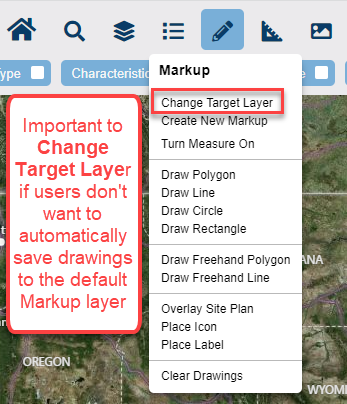
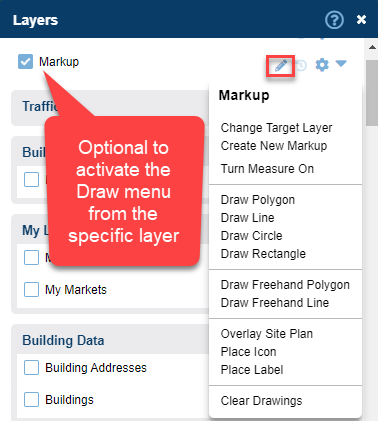
Note:
The Markup layer in your Layers Menu is provided to all users by default and is where all drawings will go if no other markup layers are created or if another markup layer is not chosen as the Target Layer. (See above Target Layer Overview for more details.)
Drawing Polygons, Lines, Circles, and Rectangles
1. Click the Drawing icon in the Main Toolbar.

2. Click Draw Polygon, Draw Line, Draw Circle, or Draw Rectangle from the menu.
Note:
After you draw, you can format the shape or line using the Drawing Toolbar (See definitions below). To delete the drawing, click the Delete button from the Drawing Toolbar.
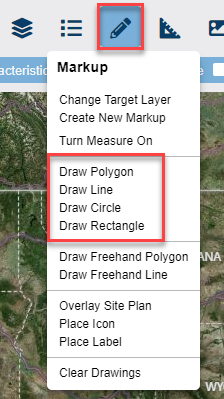
3. Click on the map to begin your drawing. Release your hold on the mouse button and move your mouse over the map to draw.
Polygons: Click at the end of a line to start a new side. After drawing the last side, double-click to close the polygon.
Line: Double-click to end the line.
Circle: Single-click to complete the circle.
Rectangle: Single-click to complete the rectangle.
Note:
There are two ways to precisely size a circle you have drawn:
First, you can input a radius value on the Drawing Toolbar. Your circle size can be in feet, miles, meters or kilometers.
Alternatively, you can select Measure On from the Drawing Tools menu before you draw a circle. While you are drawing, the Measure Tool dynamically displays the circle's circumference, radius, and area. To turn off the Measure Tool, select Measure Off from the Drawing Tools menu. (See related documents below)
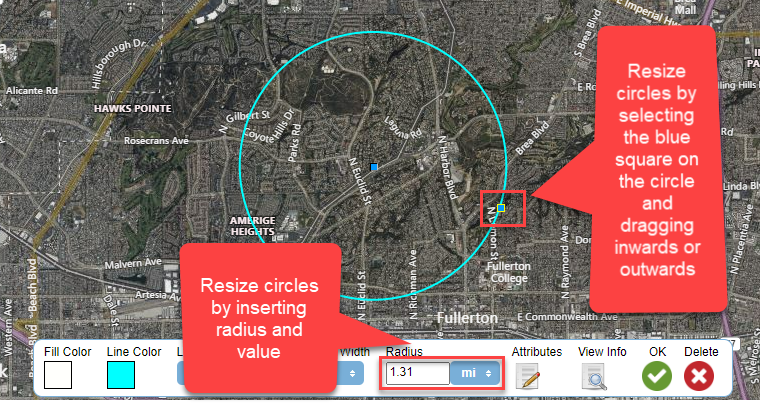
Reformat / Edit Drawings
The Drawing Toolbar appears at the bottom of the map screen once a Drawing layer is active and will also reappear if a specific drawing is directly clicked on

Fill Color: Select the fill color and opacity for the drawing by clicking on the Fill Color color swatch. The Fill Color window appears. (See How to Use the Color Selector below for instructions.)
Note:
Fill color does not apply to lines.
Line segments cannot be merged
Line Color: Select the line color for the drawing by clicking on the Line Color color swatch. The Color Selector window appears. (See How to Use the Color Selector below for instructions.)
Line Style: Select the line style from the drop-down list.
Line Width: Select the line width from the drop-down list.
Attributes: Add a note or label for your drawing.
View Info: Click on Edit Attributes in the Markup window to modify your drawing.
OK: Click to accept your selections. The Drawing Toolbar closes and the drawing is de-selected.
To Rotate a Polygon
1. Select the polygon by clicking on it or selecting it from the tooltip pop-up.
2. Click and hold the small circle in the polygon while moving the mouse to rotate the orientation.
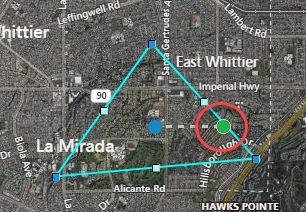
To Delete a Polygon, Line, Circle, or Rectangle
1. Click on the drawing if it isn't already selected so that it is active (small blue squares will appear on the drawing when in edit mode).
2. Click the Delete button on the Drawing Toolbar

Placing an Icon on the Map
1. Click the Drawing icon in the Main Toolbar.
2. Click Place Icon on the menu.
Note:
Before you place the icon on the map, you can move it using your mouse and format it using the Drawing Toolbar. To cancel placing the icon, click the Delete button on the Drawing Toolbar.
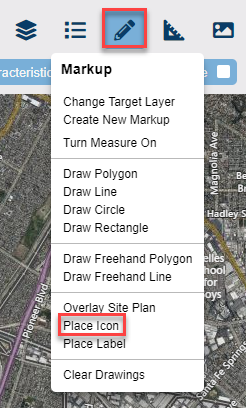
3. Click on the map where you'd like to place the icon. You can move the icon by clicking on it, and while holding the mouse down moving it to your desired location. To de-select the icon, click on the map. To select the icon, click on it. A selected icon is boxed.
Note:
You can rotate a selected icon by clicking on the green point at the end of the dashed line, and while holding the left mouse button down and turning it to your desired location.
Formatting Icons on Draw Toolbar
The Drawing Toolbar appears at the bottom of the map screen once an icon is active.
Image: Click on the Image icon. The Image window appears. Select an icon from the Public or Custom tab, or load a new icon by clicking the Upload button on the Custom tab. |
|
Fill Color: Select the fill color and opacity for the icon by clicking on None or the Fill Color color swatch. The Fill Color window appears and a box can be enabled next to Use Color to pick a color on the outer rim of the circle and the shade of that color within the circle. Below the color wheel is an Opacity Slider that lets you drag over how dark or light of a shade the color will be. Choose OK to confirm the changes. |
|
Size: Select the size of the icon from the drop-down list. Options range from size 8 to 96 |
|
Attributes: Add a note or label for your icon. Choose Save once text is inserted. |
|
View Info: Click on Commands at the bottom of the Markup window to modify your icon (See Markup Window Commands below for definitions of the menu options). |
|
OK: Click to accept your selections. The Drawing Toolbar closes and the icon is de-selected. |
|
Deleting an Icon
1. Click on the icon if it isn't already selected so that it is active (a selected icon is boxed).
2. Click the Delete button on the Drawing Toolbar.

Placing a Label on the Map
1. Click the Drawing icon in the Main Toolbar.
2. Click Place Label on the menu.
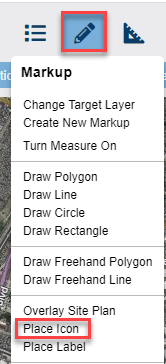
3. Type your label in the Enter Label Text window. You can use multiple lines of text.
4. Click the Ok button.
Note:
Before you place the label on the map, you can move it with your mouse and format it from the Drawing Toolbar. To cancel placing the label, click the Delete button on the Drawing Toolbar.
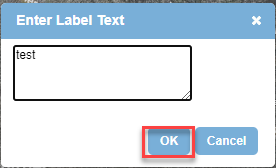
5. Click on the map where you'd like to place the label. You can move the label by clicking on it and while holding the mouse down to move it to your desired location. To de-select the label just click on the map. To select the label, click directly on it. A selected label is boxed.
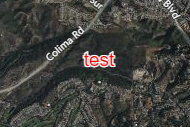
Note:
You can rotate a selected label by clicking on the greet point at the end of the dashed line, and while holding the left mouse button down and turning it to your desired location. This feature is useful when you need to place street labels on the centerline of a street.
Editing Label Text
1. Click the label so that the Drawing Toolbar appears at the bottom of the screen
2. Click the Attributes Icon on the Drawing Toolbar.

3. Edit the text in the Label field of the Edit Attributes window.
4. Click the Save button.
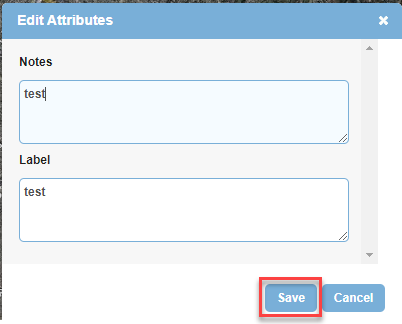
Formatting a Label Color/Font/Size etc.
When the label is selected and the Drawing Toolbar is at the bottom of the page, there are options within to do the following changes:

Fill Color: Select the fill color and opacity for the label by clicking on the Fill Color color swatch. The Fill Color window appears. (See How to Use the Color Selector below for instructions.)
Line Color: Select the line color for the label by clicking on the Line Color color swatch. The Color Selector window appears. The line color outlines the text. (See How to Use the Color Selector below for instructions.)
Font: Select a font from the drop-down list.
Font Size: Select a font size from the drop-down list.
Geo Lock: The Off default setting enables you to view a label no matter how far you zoom out. The On setting enables you to lock a label to geographic scale. That means that the label acts like any feature on the earth, such as a house. The further you zoom away from it the less you can see it, until it disappears.
Attributes: The Edit Attributes window enables you to add or edit Notes. In addition, the Label field displays your label text, which you can edit if desired.
View Info: Click on Commands at the bottom of the Markup window to modify your label. (See Markup Window Commands below for definitions of the menu options.)
OK: Click to accept your selections. The Drawing Toolbar closes and the label is de-selected.
Delete a Label
1. Click on the label if it isn't already selected so that it is active (a selected label is boxed).
2. Click the Delete button on the Drawing Toolbar.

Overlaying a Site Plan (Image) on the Map
An image can be placed on the map using Overlay Site Plan and the transparency of the image can be adjusted as well. PDF files are not supported for Site Plan Overlay but it does accept .gif, .jpg, .tiff, and .png files.
1. Click the Drawing icon in the Main Toolbar.
2. Click Overlay Site Plan on the menu.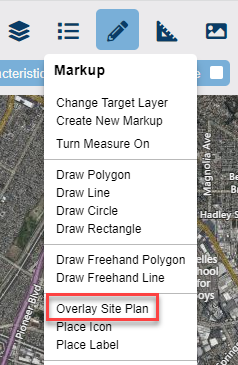
3.Select an Image from the Shared or User tab, or load a new image by clicking the Upload button.
Tip:
Hovering your mouse cursor over the images will allow you to see the file names of images already loaded.
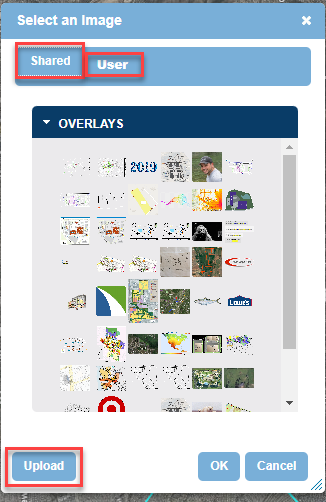
4. Click the OK button. The image loads on the map, and the Set Control Points window opens in the upper right corner of LightBox Vision.
5. Follow the steps in the Set Control Points window to place the image on the map (or choose Skip and see the below section for Aligning Images). There will be a toolbar at the bottom that allows you to adjust the opacity of the image.
6. The Site Overlay image is now attached to the layer called “Markup” in your Layers Menu and can be turned off or turned on from your map view by selecting the checkbox next to that layer.
Using the Set Control Points Window
Please select a point on the image. Click on the image at the first point you would like to set on the map. For example, you might click on the bottom left corner of the image.
Now select the corresponding point on the map.
Move the cursor, which is at the tip of a black arrow, to the place on the map that the place you selected in your image corresponds to.
Click to set this first control point. A blue pin LightBox Vision Draw Overlay Blue Pin appears at the point.
Please select another point on the image. Click on the image at the second point you would like to place on the map. For example, you might click on the top right corner of the image.
Please select a corresponding point on the map.
Move the cursor/arrow to the place on the map that you just clicked on the image.
Click to set this control point. This places the image, in a bounding box, at the desired location on the map. The Drawing Toolbar also opens. You might have to align your image to place it perfectly on the map (See below for tips)
Aligning Images on the Map
1. Click and drag the arrows cursor to move the image.

2. Click on the green point at the end of the dashed line LightBox Vision Draw Overlay Blue Pin Pivot to pivot the image around the blue pin.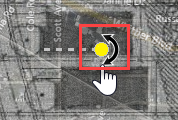
3. Click and drag a corner point LightBox Vision Draw Overlay Resize on the bounding box to resize the image.

Formatting the Image
Select the image to edit it if it isn't already selected. The Drawing Toolbar opens when you are in edit mode.

Tip:
If you have difficulty selecting the image, enable the Identify features on your target layer in the Layers menu. Click the button nearest to the layer name, When the "i" icon is crystal clear, that means the layer is identifiable.
Image: Displays a thumbnail of your selected image.
Opacity: Select the opacity for your image. The opacity range is 5% (clear) to 100% (no opacity). An image with 5% opacity is not visible on the map.
Attributes: Add a note or label for your image.
View Info: Click on Commands at the bottom of the Markup window to modify your image. (See Markup Window Commands below for definitions of the menu options.)
OK: Click to accept your selections. The Drawing Toolbar closes and the image is deselected.
Delete: Delete the image.
Change the Target Layer
1. Click the Drawing icon in the Main Toolbar.
2. Click Change Target Layer.
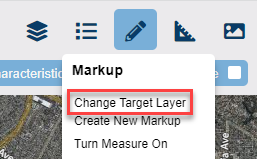
3. Select a target layer from the drop-down menu of the Set Target Layer window.
4. Click the OK button. The top of the Drawing Tools menu displays the name of your selected target layer.
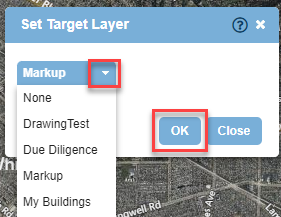
Creating a New Markup Layer
1. Click the Drawing icon in the Main Toolbar.
2. Click Create New Markup in the menu.
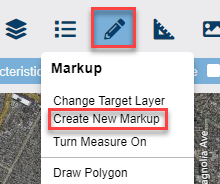
3. In the Create New Markup Layer window:
Select a Folder from the drop-down menu to save your new markup layer. Your Drawings folder is the default. Only you have access to view and edit its contents (if sharing is desired, choose Share folder)
Type a Name for your new markup layer.
Click the OK button. LightBox Vision assigns your new markup layer as the target layer. Its name appears at the top of the Drawing Tools menu.
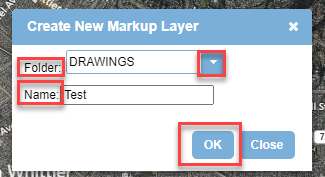
Using the Measure Tool
Use the Measure Tool to accurately measure any parcel or any area (polygon or circle) or line that you draw on the map (see Related Documents below)
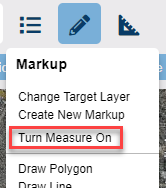
How to Use the Color Selector
The Color Selector works the same for both Fill Color and Line Color, except that the opacity setting does not apply to Line Color. Each color has Red, Green, and Blue (RGB) values. The values range from 0 to 255. Fill Color has an Alpha value for opacity. Opacity value ranges from 0.0 (clear) to 1.0 (solid color).
Tip:
If you want to use the exact same color more than once, it is best to write down its RGB values. For Fill Color, also write down the Alpha value for opacity. In the Color Selector window, enter the values in the appropriate fields.
If the box next to Use Color is not checked, click it to activate the Color Selector.
To pick a color using the Color Wheel, click on the wheel. To change the shade of the color, move your mouse in the box inside the wheel.
To select the opacity for Fill Color only, move the slider.
Markup Window Commands

Click the View Info icon LightBox Vision Draw Icon View Info on Drawing Toolbar to open the Markup window. Click the More dropdown. Here are the unique commands on the menu:
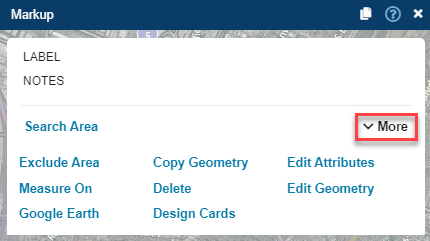
Copy Geometry: Enables you to copy a drawing from one layer to another.
Edit Geometry: Resize the drawing
Search Area (Add as an Inclusion): Allows you to make drawings a confined area for searching. See related Search documents
Exclude Area (Add as an Exlusion): Allows you to make drawings an exclusion from searches. See related Search documents
View in Google Earth: Lets you open Google Earth view of a drawing. See related Search documents
Delete: You can delete the specified drawing/icon/label/image
Measure On: This will show the measurements of your drawing
Edit Attributes: Gives the ability to edit labels or notes
.png)


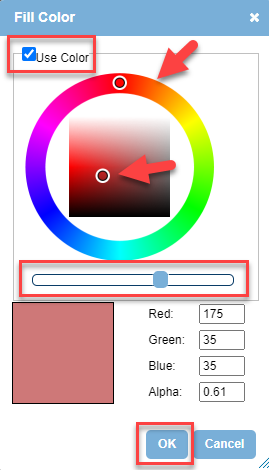
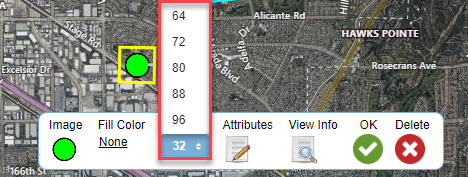
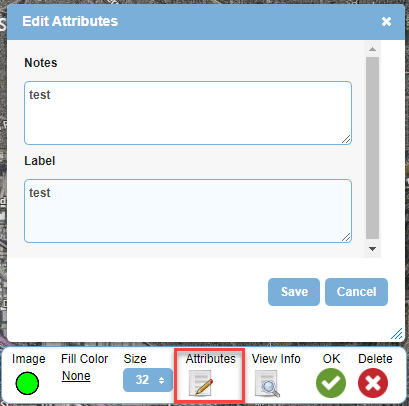

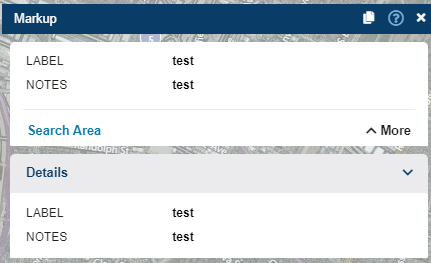

.png)